How to Read the Staff
Mastering the staff is essential for interpreting sheet music on the guitar. The staff consists of five horizontal lines:

The placement of bar lines is determined by the number of notes in the bar and the time signature, which will be discussed later on. Each bar has a consistent duration unless specified otherwise by the time signature.
Clef Symbols
At the beginning of a staff, a symbol known as a clef is placed to indicate the type of staff being used. There are three main types of clefs in music: G Clef (Treble), F Clef (Bass), and C Clef (moveable).
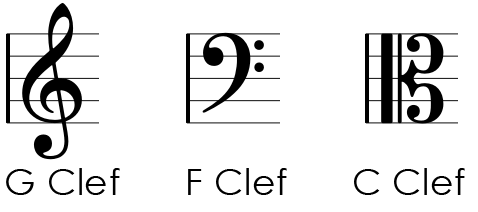
In guitar sheet music, the Treble clef is typically used, while bass sheet music usually employs the Bass clef.
The little curve at the end of the Treble clef is positioned near the second line, indicating that this line represents the note G.
The C clef is typically not discussed in this guide due to its usage with other instruments.
Staff Note Positions
Now that the Treble clef is set, let's explore the note positions on the staff.
Each of the five lines can hold a note to represent a specific pitch, as shown below:
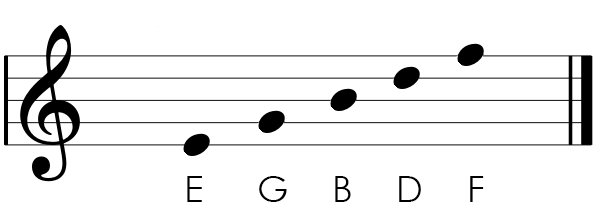
The first line is C, the second line is E, the third line is G, the fourth line is B, and the fifth line is D.
We can also place notes in-between the lines which are called spaces.
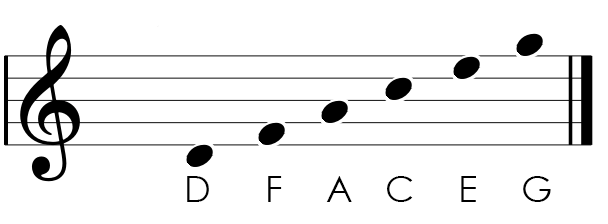
The space below the bottom line is D, the bottom space is F, the second space is A, the third space is C, the fourth space is E, and the space above the top line is G.
Here are all of the notes in the staff when we combine the lines and spaces:

If you count all of those dots, you end up with eleven notes.
When playing the guitar, we have the ability to produce a wide variety of sounds by utilizing different fret positions along the fretboard.
Ledger lines
The lowest note shown above is D below the bottom line. What if we wanted to play a note lower than this?
To represent notes outside the staff, we can use ledger lines. These short lines extend the staff above or below the five lines.Here are a few examples of ledger lines below the staff:
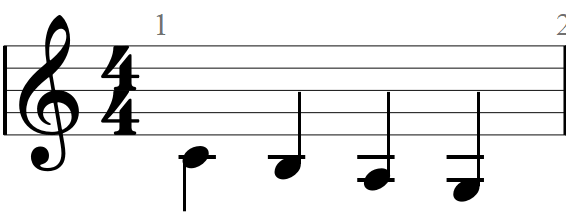
The first ledger line below the staff represents the note C, which is one step lower than the lowest space note, D.
The space below this ledger line is B, followed by A on the second ledger line.
Here are a few examples of ledger lines above the staff:
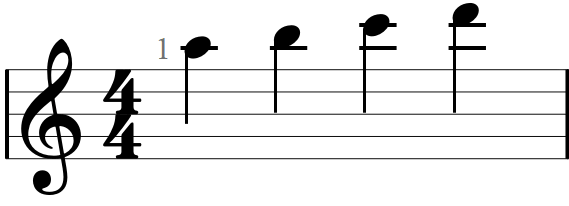
The very first note is on a ledger line above the staff. We know that the highest space above the staff is G, so the next note up from G is A.
Just above this ledger line is the note B, and the note C is on the second ledger line.
8va and 8vb
We can continue adding ledger lines as needed, but
using too many can make the music difficult to read.
For very high or low notes on the guitar, instead of ledger lines, we can use a symbol to shift the staff up or down an octave.
In the below example, you can see that there is ‘8va’ and a dotted line written above the staff.

To make reading music easier, notes can be written an octave higher or lower than they actually sound. This is indicated by using 8va for an octave above or 8vb for an octave below. Additionally, for notes that are extremely high on the fretboard, the symbol 15ma is used to represent two octaves above.

When it comes to really low notes on the guitar, things can get a bit tricky. While most standard tunings can be notated with 8vb, some guitarists use alternate tunings that may require different notation. In these cases, you might encounter the bass clef, which positions notes differently than the treble clef. Don't worry if this seems confusing at first - focus on matching the notes on the staff to the guitar fretboard as you practice.
Later on, when you start seeing ledger lines or 8va/8vb symbols in music, you can come back and refresh your knowledge.
Finding Notes on the Guitar
Now that you know how to read the basic staff and the note positions on the staff, let’s look at how to find those notes on the guitar fretboard.
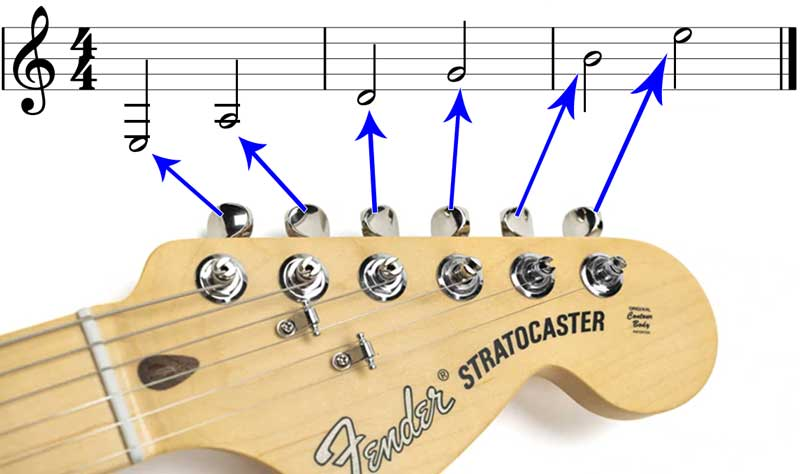
Let’s start by finding the open string notes on the staff.
When looking at the diagram, you'll notice that the open string notes span across a wide range of the musical staff.
For the lower strings E and A, ledger lines are commonly used, so you'll often encounter 8vb markings when playing lower riffs.
The high E string aligns with the top space on the staff. This implies that all notes on the E string are positioned above the staff, leading to frequent use of ledger lines or 8va for high melodies and solos.
Let's explore the C Major scale played from the low open E string up to the high E string:

When reading guitar sheet music, it's important to note that the notes on the staff may not directly correspond to the notes you play on your guitar. The sheet music is written in a higher octave than it sounds, so keep in mind that what you see on paper may sound different when played on your guitar.
The technical reason for this is because the guitar is a transposing instrument. The note you hear sounds an octave lower than written.
This doesn’t affect the way you read music, but if you share sheet music with musicians who play other instruments, you will notice a difference in what they play with your sheet music.
Sharps and Flats
After familiarizing yourself with the notes on the staff, it's important to explore the intermediary notes.
For instance, consider the notes C, D, and E (open, first, and third frets) on the A string:

To represent these in-between notes on the staff, we utilize sharp and flat symbols.
A flat symbol (looks like a ♭) indicates to play the note one semitone lower. On the guitar, one semitone is equivalent to one fret distance.
Therefore, to play the second fret on the high E string, we would use a flat symbol to the left of the note F to indicate that we want to play a note one semitone lower than F:

This note is called ‘F sharp’. It is one semitone higher than F.
Another option is to use a flat symbol (resembling a lowercase b), indicating that the note should be played one semitone lower.
For example, instead of referring to the note on the second fret as F sharp, we can refer to it as G flat because it is one semitone below G.

Remember, when you come across a note with a flat symbol next to it, simply shift down one fret to play it.
Keep an eye out for the natural symbol that appears next to the note G, as it has a special meaning that will be explained later on.
Check out these additional examples of sharp and flat notes.

Practice identifying the names of these notes, then locate them on the fretboard.
Consecutive Sharp and Flat Notes What if you need to play four F# (F sharp) notes in a row?
In Standard Notation, you only write the sharp symbol once and assume the same note is repeated for the next three instances.

In the above example, it may look like you need to play C# followed by three C notes, but it is actually four C# notes. The sharp symbol continues until the end of the bar.
If you want to continue to play C# in the next bar, you will see the sharp symbol appear the first time C# is played again in the second bar.

In the example provided, there are a total of eight C# notes, with four in each of the two bars. The sharp symbol is indicated only once in each bar, specifically at the first occurrence of C#. Subsequent instances of C notes should be played as C# without the need for additional sharp symbols.
Natural Symbols
What happens if you play an F#, then you want to play F after it in the same bar?
To do this, we use a natural symbol as shown below:

The natural symbol indicates to play the note without any sharps or flats, returning to the original pitch.
To understand how these work, let’s play the notes F F# F# F F F# F F:

When reading the example above, remember to go through each note one by one, starting from the left. If a note doesn't have a symbol next to it, refer back to the previous note to determine its value.
In the example provided, you'll notice that a natural symbol is only necessary when transitioning from F# to F.
The absence of a natural symbol at the beginning of the bar is due to the fact that there is no sharp symbol preceding it (a concept that will be further explained in the section on key signatures).
Staff Notation - How To Read Lines